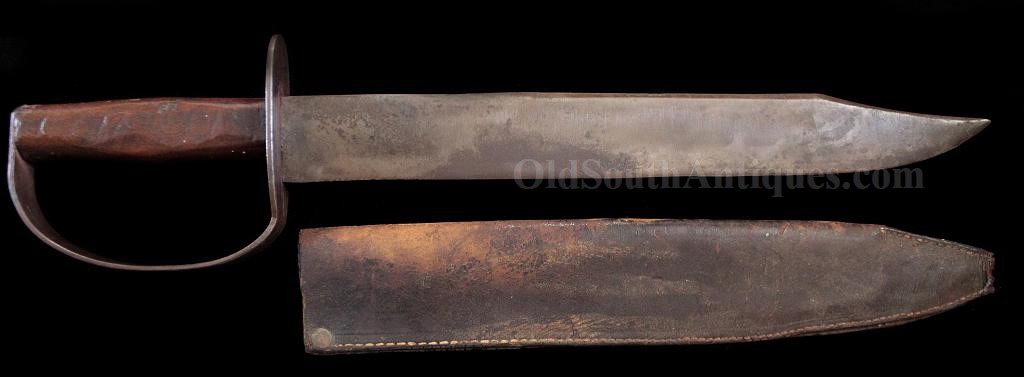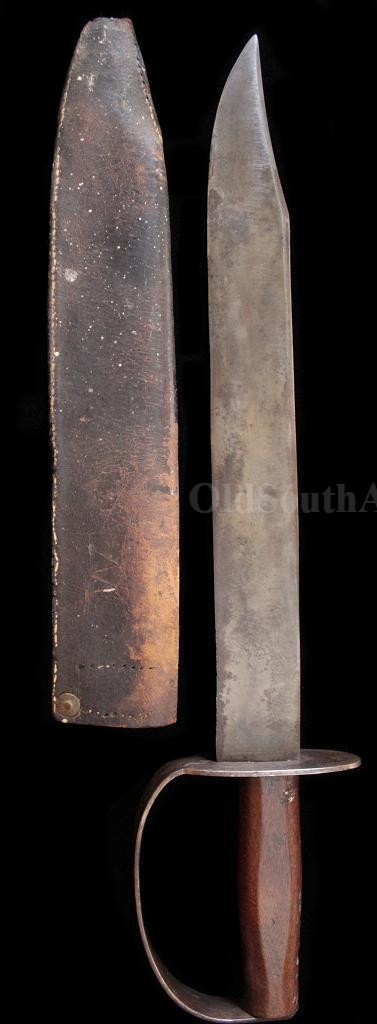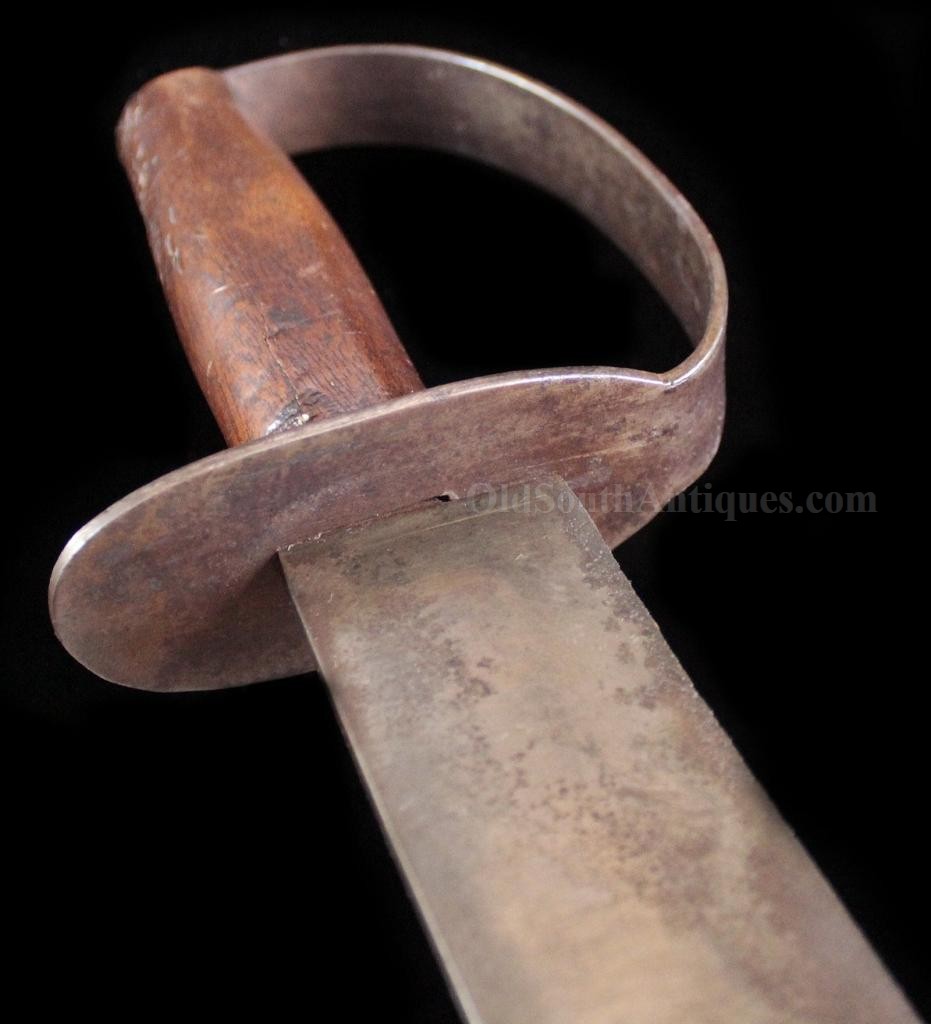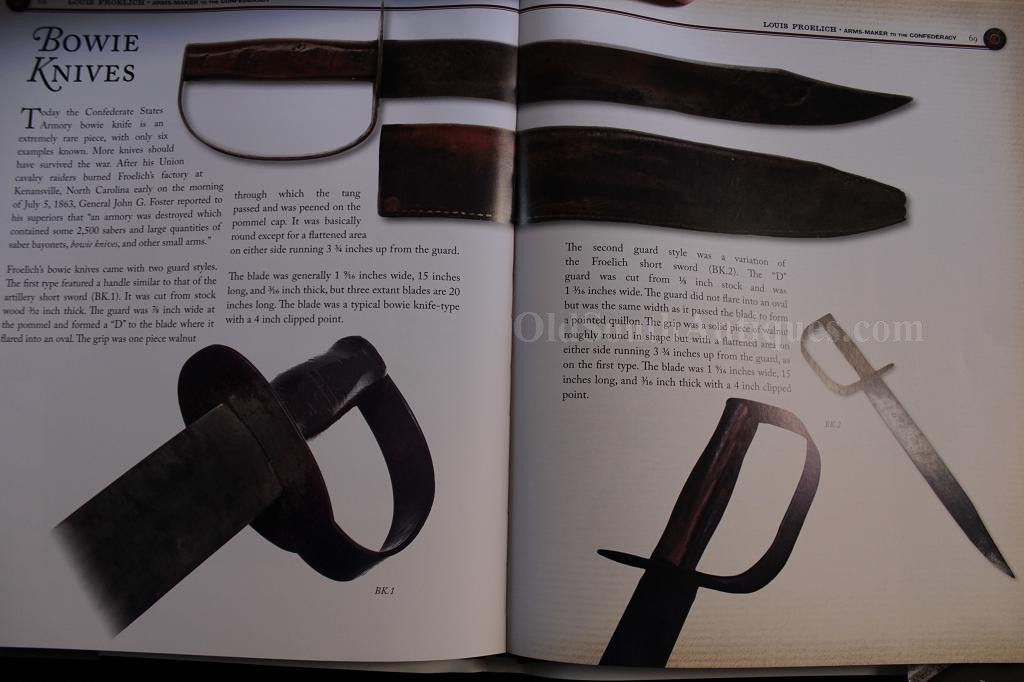
| Catalog | Past Items | Order Info | Terms/Conditions | About Us | Inventory Clearance |
For more than half a century the maker of the D-Guard knife shown here has been misidentified as a product of Louis Froelich’s CSA Armory in Kenansville, North Carolina. How this misidentification came to be makes no difference; how it has been properly identified as a Burger/Boyle & Gamble, Richmond, Virginia product does.
The story begins when I purchased a Bowie knife that had a grip like those found on Burger & Brothers’ knives, and a blade like the very distinctive Froelich identified knife with a triangular shaped flat on each side at the ricasso. It was also interesting to note that it was in its original, tin scabbard with the design characteristics of the Boyle & Gamble knives. This opened my eyes to the possibility that the knives had been misidentified.
Following extensive research, I found that through this last half century, no example of a knife commonly called a "Kenansville” has been discovered which had a Louis Froelich/CSA Armory maker mark. Nor have any been discovered bearing the Roman Numerals so often found on Froelich products. After canvasing the old time Kenansville site relic hunters, I found that no one had ever found a part of a "Kenansville” knife in the vicinity. Over a period of time, I discovered a Burger Brothers marked example of the distinctive knife known as a "Kenansville Clip Point D Guard”. I also found a Boyle and Gamble marked example without its scabbard, and I found a Boyle & Gamble marked example with the original tin scabbard. The tin scabbard exhibited the traits of the known Boyle & Gamble tin scabbards.
In the National Archive files I found receipts for hundreds of "Artillery Knives” made by Burger/Boyle & Gamble. In my own mind, the above information was enough to convince me that Burger/Boyle & Gamble made these knives. However, changing 50 years of public opinion cannot be undertaken lightly so I did not disclose my findings and kept looking for more confirmation. That confirmation came in the form of a knife captured from Samuel Wilson of the Goochland Light Artillery at the Battle of Carnifex Ferry. On September 10, 1861 the battle was fought throughout the afternoon. The Yanks were repulsed at dark, and Confederate forces withdrew during the night. The Yankees advanced the following morning to claim the camp. At the time of the battle, Samuel Wilson was in Captain Guy’s Goochland Light Artillery. I find no record of him having been captured in the battle, so the knife must have been left in the camp during the retreat and the label identifying its time (9/10/61) and location of capture put on it by the captor.
John McAden’s Louis Froelich Arms Maker to the Confederacy reports the establishment of Froelich’s manufactory in September of 1861. However, Wilson’s knife had been delivered, issued, and captured by the time Froelich was in operation. This leaves no doubt that the "Kenansville” knives, cannot have been made at Kenansville.
We have invoices for many "Artillery Knives” by Burger/Boyle. No doubt in my mind this local Goochland County Company was issued these "Artillery Knives”, though I do not have their particular invoice.
Prior to the War Between the States, Edwin Boyle and the Burger Brothers were in the saw manufactory business. When the Northern states invaded Virginia, Mr. Boyle joined with a P. Gamble and began the manufacture of various types of edged weapons, including knives and swords for private purchase and for the Confederate Government. The Burger Brothers had a much smaller production, but they too made swords and knives. I would like to think that the Burgers and Mr. Boyle were motivated by patriotism; but I am sure, as an astute businessman he could see that there was going to be a bigger demand for swords than saws.
Most of Burger Brother’s and Boyle & Gamble’s products are unmarked; fortunately, they did mark enough of each type of weapon for the modern collector to readily identify their unmarked products. The rarest and most desirable pattern of these knives is the Clip Point D-Guard. Louis Froelich Arms-Maker to the Confederacyby John McAden, Jr. and Chris Fonvielle, Jr., show this exact knife on pages 68, 69 and 70. According to this reference, only six of these rare knives are known to exist, and to the best of my knowledge only two of the six retain their original scabbards. This is one of the two; the other recently sold for $27,000.00 at auction. This example is in beautiful condition, the blade has a little bit of rust staining, but it still retains its original browning and the grip and guard remain tight. The scabbard is missing its belt loop and tip, otherwise it is very strong and all stitching is tight. There are little white spots on one side of the scabbard; I happen to know how they got there. Some ten years ago a small, clap board antebellum out house (not outhouse) was being disassembled on Virginia’s Eastern Shore. This knife was hidden inside the wall between the plaster and the clap board. When the clap board was painted, little white paint speckles would be thrown into the hollow wall between the boards and each time a few speckles would hit the hidden knife. I would love to know the story of how it came to be hidden there.
Copyright © 2024 OldSouthAntiques.com All Rights Reserved.
Privacy Policy | Terms of Use
Powered by Web-Cat Copyright © 1996-2024 GrayCat Systems



